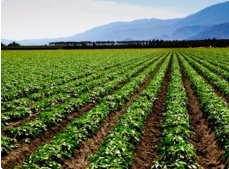Sustainable Soil Technology
 When addressing sustainability, most would accept that soil is a critical resource. Importantly, unlike for instance air and water, soil is the environmental resource that is largely within a farmer’s direct control. Soil health and fertility is dependent upon its physical state, biological activity, organic content and nutrient availability to plants. Sick soil produces sick plants, sick animals and sick people. Laudably the Government’s Strategy for Sustainable Farming and Food has a vision of the future “….of the efficient use of environmental resources that are at the heart of our way of life …. producing safe nutritious food …. health of the whole nation”. Yet in its 50 pages soil is mentioned five times and nutrients just once.
When addressing sustainability, most would accept that soil is a critical resource. Importantly, unlike for instance air and water, soil is the environmental resource that is largely within a farmer’s direct control. Soil health and fertility is dependent upon its physical state, biological activity, organic content and nutrient availability to plants. Sick soil produces sick plants, sick animals and sick people. Laudably the Government’s Strategy for Sustainable Farming and Food has a vision of the future “….of the efficient use of environmental resources that are at the heart of our way of life …. producing safe nutritious food …. health of the whole nation”. Yet in its 50 pages soil is mentioned five times and nutrients just once.
Information on the health of our soils is limited, and scientific understanding is lacking in many areas. The last large scale testing was in 1979/81 with partial representative re-sampling in 1995. This indicated that some soils still had high organic matter content at around 7-10% plus, but during the period there had been a further overall loss of one fifth of the organic matter, with 40% of the soils having organic matter of only between 0% and 3.6%. This significant loss of organic matter in our soils has both environmental and land management implications – and opportunities.
Linked with the reduction of organic matter, generally there will be a reduction in soil nutrients – not necessarily NPK – but the minerals/trace elements of copper, iodine, cobalt, selenium, boron, chromium, magnesium, manganese etc. that are, at natural levels, essential for plants and animal health. This critical deficiency issue is not considered in either the Environment Agency Report on State of the Soils nor the Defra Soil Action Plan.
For the conventional farming system the signs and symptoms of soil trace element deficiency can be insidious. Over a period the growth response to fertiliser slowly falls away, crops and animals become less disease-resistant. Livestock fail to thrive, take longer to finish, need more mineral buckets, boluses and medication. Dairy cattle need more and more cake to produce sufficient milk, fertility declines and the cull rate rises. Mastitis and poor feet are common and the herd becomes more and more time-consuming. For the sheep farmer, lambing percentage falls, mortality rates rise as more animals succumb to the traditional diseases with an endless round of drenching, worming, dagging, treating scald & footrot, and the lambs no longer finish on grass.
Whilst organic farming systems seek to maintain or restore mineral levels over time, a particular problem can arise when a hitherto intensively farmed conventional unit goes into organic conversion, whereupon the soil deficiencies and imbalances show up in stark relief. Without help, conversion in such circumstances can take many years and break both hearts and wallets.
If your soils are tested comprehensively and regularly for trace elements, it is possible to spot the developing problems and prevent further deterioration, and redress the balance. A blanket proprietary application approach is not only resource inefficient, but could even be detrimental to your soils. The application of trace elements that are formulated specifically for the deficiencies identified in your soils ensures that yields and growth rates are optimised and input costs, particularly of fertilizer, added minerals and to a lesser extent pesticides, drop sharply.
Put simply Sustainable Soil Technology, rectifying trace element deficiencies in soils produces healthy plants, healthy animals and people, and enhances the sustainability of the whole food cycle. Economically, it also enhances your bottom line.
Dave Stanley is an independent Sustainability and Environmental Management Consultant working with Field Science. Contact: Tel 01778 424443
